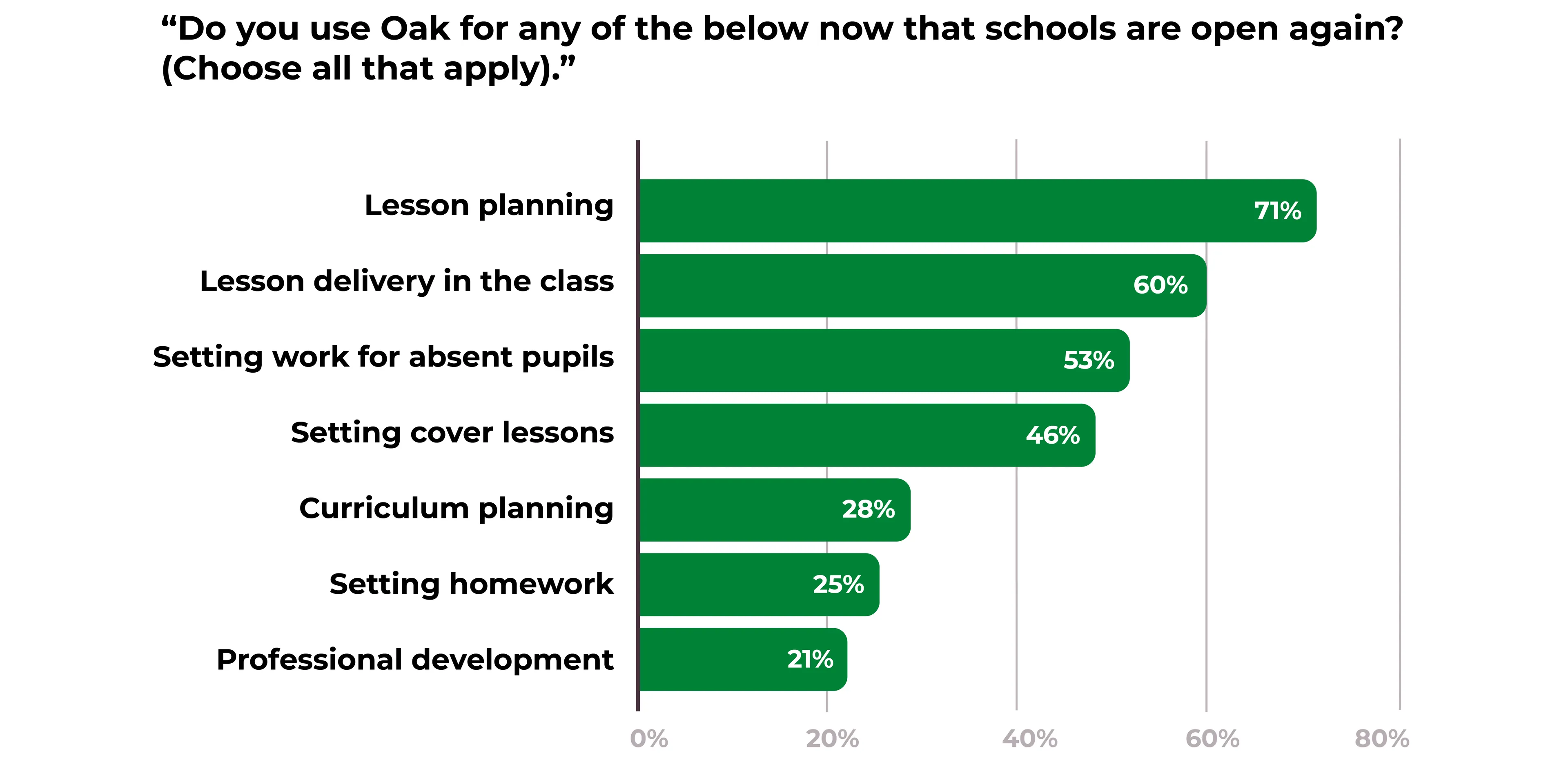
Categories
Research and insights
1 July 2021After lockdown: How have teachers used Oak resources since schools fully re-opened?

Reka Budai
Research and Evaluation Manager
As the research and evaluation manager at Oak, part of my job is to continuously engage teachers through surveys and interviews to learn more about their needs and make sure that their voices shape any new lessons and improvements.
During the third lockdown with its nationwide school closures our platform’s usage skyrocketed, seeing almost a million users on peak days. We asked teachers back then about their plans to keep using Oak, and 75% of teachers indicated that they intend to make use of Oak’s resources beyond this school year.
Teachers - ever the innovators - have started using Oak in ways other than managing remote learning.
School openings in March brought some uncertainty around whether we are still relevant when schools are almost running as usual, and classroom teaching is again the norm. We are pleased to see that each week still around 150,000 pupils and 30,000 teachers use Oak.
However, what was the most interesting to learn about in our recent research is that teachers - ever the innovators - started using Oak in various ways other than managing remote learning.
As the below chart shows, these uses range from in class teaching to contributing to their professional development. Let’s deepdive into each!

Oak survey with 431 teachers (May 2021)
1. Lesson planning & delivery
Most of our lessons come with downloadable slides (copyright permitting) that can be adapted to the style and needs of the teacher and delivered in the classroom. What we were slightly more surprised to hear is that teachers make great use of our video lessons in the class as well.
They ‘co-teach’ or ‘team-teach’ as they described this practice, meaning that they project Oak videos to the class, pause to check for understanding and initiate whole class discussions.
One teacher told us they used the videos in class, then felt more confident in teaching the topic from that basis.
Even for experienced teachers there comes a time when they need to teach a subject, year group, or even just a topic that they are non-specialists in. One teacher told us that despite being a Computing teacher, the programming language Python was not her expertise. She used the videos in class, then felt more confident in teaching Python from that basis.
Using Oak for lesson planning is slightly more prevalent (71%) than using it for actual delivery (60%). This is expected, considering that some teachers prefer to use videos and slides as inspiration only and deliver their own tried-and-tested materials adapted to the needs of their class there and then.
2. Catch-up for absent students
Our main use case during the pandemic is now only in third place, still, more than half of surveyed teachers use Oak to support students outside school.
First, even with the worst of the pandemic hopefully behind us, there will still be occasions when pupils miss classes due to various reasons.
Second, some pupils might struggle with certain concepts and need more time to gain an in-depth understanding at their own pace. One teacher said she uses Oak like a “doctor prescribing medicine for every individual’s specific needs”.
Teaching Assistants do tremendous work to help pupils who need more support, however video lessons watched at home can provide additional reinforcement too. As one teacher put it: “Oak is like having a second teacher in every pupil's home.”
"I don’t have to worry about printing out masses of resources and checking for different things and putting together explanations for students. I can literally just send a link to the lesson and that’s the entire workload!"
3. Cover lessons
Providing materials at speed for cover lessons can be very stressful, as can taking a class at short notice. Almost half of the surveyed teachers indicated that they use Oak as a ready-made solution for cover lessons.
Knowing exactly what will be covered in the lesson can give a sense of control and predictability, and also, there is no lengthy preparation required from either end. The supply teacher can be directed to the material by sharing just a link to the video lesson, which then can be played to the class, paused for discussion when required.
4. Setting homework
Although Oak is probably not a top of mind resource for this purpose, 25% of teachers said that they use Oak to set homework.
What we have found in our teacher interviews is that homework takes various shapes and forms these days, from light-touch quizzes to chunkier research projects.
Having experienced months of online learning, pupils are naturals at using the digital platform independently.
Oak’s collection of resources can thus be repurposed as homework, from asking pupils to watch a section of a video, complete worksheets or have a go at some low stakes quizzing.
5. Professional development
Understandably, many teachers told us that they prefer not to share the limelight in the classroom with a video version. But even many of those who would refrain from using video lessons in class said that they would watch our pre-recorded lessons to help prepare for and plan their lessons.
This approach has had particular value for newer teachers. One NQT teacher said that there is never enough time to observe other teachers teaching, so he would watch the relevant Oak lesson and use that as a basis to model his own classes, picking up its flow and structure.
One NQT said there is never enough time to observe other teachers, so he would watch the relevant Oak lesson and use that as a basis.
Another teacher even revealed she watched the videos at double speed while drinking her morning coffee to refresh her memory on a topic before going to work.
Still, what we have found is that Oak is not engaged with as a usual, dedicated form of CPD, but is used rather in an implicit way.
As one teacher said: “When you use Oak, you are doing CPD”, and indeed when teachers adapt the readily available slides, take inspiration from quizzes or observe other teachers teaching, they might all learn something new along the way.
Reka Budai, research and evaluation manager at Oak National Academy

